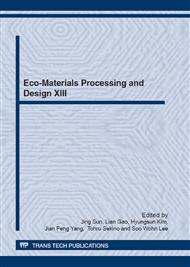p.131
p.135
p.139
p.143
p.147
p.151
p.155
p.159
p.163
Reduction Effects of Urban Heat Island by Water-Retentive Pavement
Abstract:
Recently, increasing of impervious surface as concrete or asphalt pavement with urban development brought increasing of air temperature in city. So many researchers have explored ways to reduce the urban heat island effect and water-retentive or water absorbing pavements have been found to be very effective. In this study, to evaluate the reduction effects of urban heat reduction of water-retentive pavement, surface temperature of pavement, air temperature, wind speed and albedo were measured for 3 years (2008~2010, summer period). And the intensity of sensible heat flux was calculated to estimate a influence on air temperature. Experimental results indicated that water-retentive was effective to reduction of air temperature by decreasing of surface temperature of pavement compare to other pavements. This is showed that water-retentive pavement can be contributed to mitigation of urban heat island.
Info:
Periodical:
Pages:
147-150
Citation:
Online since:
June 2012
Authors:
Keywords:
Price:
Сopyright:
© 2012 Trans Tech Publications Ltd. All Rights Reserved
Share:
Citation:


